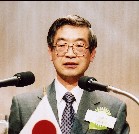��Diverging Student Real Conditions and Its Direction�ɡ�
March 15, 2006
Mr. Katsumi Tenjyo,
Associate Professor,
Nihon University
��
 The Tokyo Metropolitan Board of Education established a new type of school. It is the Challenge School, municipal Kirigaoka High School. The Tokyo Metropolitan Government has already opened 4 so-called challenge schools to actively accept students who have become truants and dropouts. The first of these is the municipal Kirigaoka High School, which opened in 2000. The definition of a truant is a student who has been absent from school for 30 days or more in a year. Nationally, there are some 130,000 such students. 10% of these are in Tokyo. There are also some 80,000 dropouts nationally, and 10% of them are in Tokyo. The most frequent reason for truancy is ��inability to adapt to school life and schooling��, followed by ��change in direction / poor academic performance��. Students attending Kirigaoka High School are those who cannot adapt to group life or who lack academic skills. 60 – 70% of the students had experienced truancy during their elementary and junior high schools. There are even some who did not attend a day of junior high school. The remaining 30% are dropouts.
The Tokyo Metropolitan Board of Education established a new type of school. It is the Challenge School, municipal Kirigaoka High School. The Tokyo Metropolitan Government has already opened 4 so-called challenge schools to actively accept students who have become truants and dropouts. The first of these is the municipal Kirigaoka High School, which opened in 2000. The definition of a truant is a student who has been absent from school for 30 days or more in a year. Nationally, there are some 130,000 such students. 10% of these are in Tokyo. There are also some 80,000 dropouts nationally, and 10% of them are in Tokyo. The most frequent reason for truancy is ��inability to adapt to school life and schooling��, followed by ��change in direction / poor academic performance��. Students attending Kirigaoka High School are those who cannot adapt to group life or who lack academic skills. 60 – 70% of the students had experienced truancy during their elementary and junior high schools. There are even some who did not attend a day of junior high school. The remaining 30% are dropouts.
There is no academic testing in the entrance examination. They also do not consider junior high school grades. There is a range in their ages. They begin as ��it��s not what you did in the past, but what you do going forward. Prior records will not be questioned��, and the students decide themselves when they will graduate.
At Kirigaoka High School, students create their own class schedules. There are three sessions, one in the morning, afternoon, and evening, and the school operates 12 hours a day from 9 in the morning to 9 at night. Students can attend classes in the session of their choosing. A system where they can study at their own pace is the major feature.
Teaching will be provided until the subject matter is understood. Most classes are in a unit of 15 students. When the class reaches 16 in number, it is split into two classes. Actually, the class is about 8 students. The output of the learning will be assessed, but giving recognition and praise is strictly enforced. There is an award for attendance. If a student has no late or absence record in a credit, a ��One Subject Attendance Award�� is given. It is an introduction of an assessment based on the positive point principle.
There is a need to foster an ��ability to relate to people��, which is a weakness among the students. Situations of relating to nature, society, community, organizations, groups, and the like, cannot be fostered through lectures. As a school curriculum of learning by doing is offered. Subjects including volunteer activities and service activities are created, and working in the community is made part of learning. For example, students go to nursing homes or welfare facilities, or are taken in by companies in a form of internship. Foster the ability to relate which is the weakness of the students, and provide them with basic and fundamental academic abilities. If these two can be overcome, success may be claimed of achieving ability to become independent in society at the least.
Caring attention is also needed for the mental aspects. Homeroom teachers will be responsible for 15 students, and provide close direction. Linked with a psychology department of a graduate school, have graduate students become friendship advisors. In addition to the homeroom teacher, a teacher would be selected by the students themselves to become a person with whom they can consult or seek advice. This teacher is called, personal tutor. These networks are referred to as the safety net. Information received during counseling are shared by their teachers and networked in providing responses.
There are children with various issues. There are reasons behind why they became what they are. By eliminating that background, I think that at least some of the issues can be resolved. There is a saying, ��ten people, ten colors��, but this does not fit in the world of education. This would mean one man, one color. Children are not of one color.
I have been saying to the teachers, provide education with the spirit of 1 person, 10 colors. Abilities of one student are in 10 colors. Truancy / dropout is only but one color, and there are 9 colors remaining. I have said that Kirigaoka High School��s education is to make these other 9 colors blossom. In such a thought, I feel I have achieved some results.